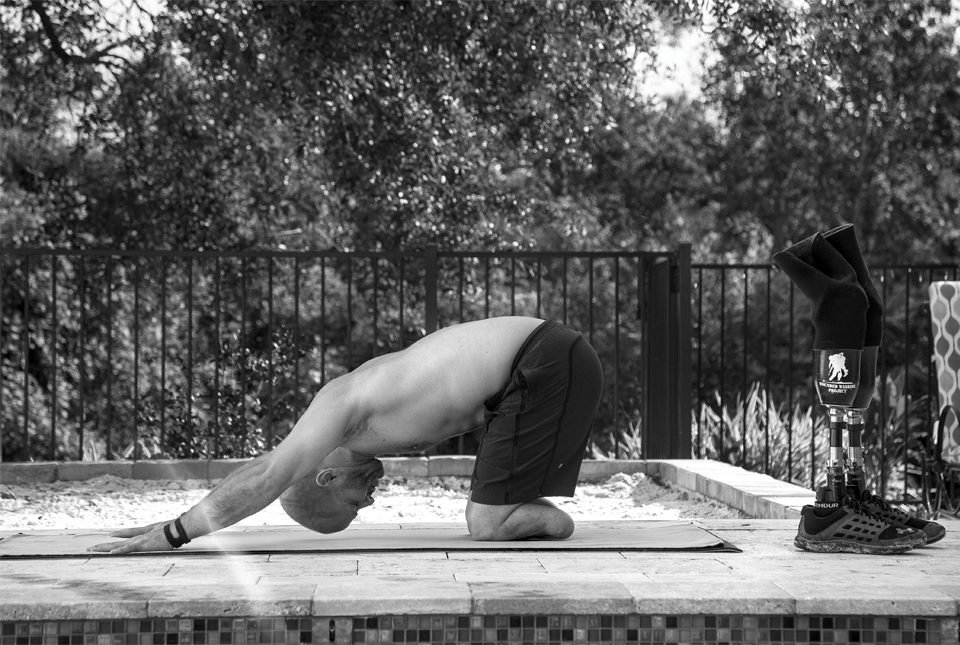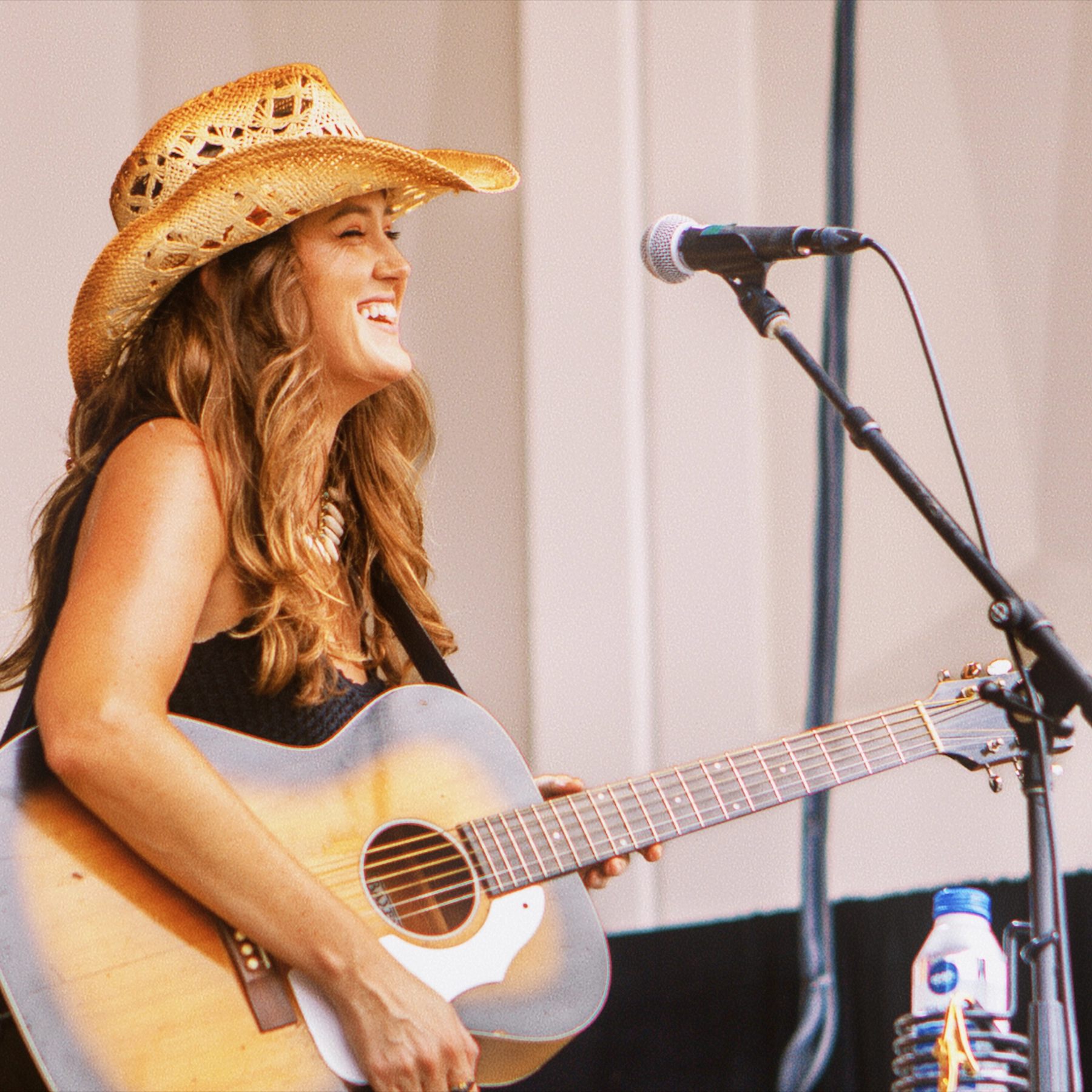by Melissa Ross | February 24, 2016
War and Peace
A soldier’s surprising journey to becoming a yogi
On a pristine, sunny morning in Ponte Vedra Beach, retired Army Staff Sergeant Dan Nevins folds his chest over his thighs with his arms outstretched and his forehead resting on a yoga mat on the pool deck behind his house. In child’s pose, the warrior finds peace, despite missing what literally connects every yogi to the earth—both of
his legs.
A decorated war hero and a bilateral below-the-knee amputee, Dan Nevins, 43, has built a cult following around the country, not for bravery on the battlefield, but for his mastery of a serene spiritual practice. How Nevins ended up practicing and teaching yoga is a story he could have never predicted. He began his journey to yoga as an enlisted paratrooper and a graduate of the Army Noncommissioned Officer Academy. He went on to college and a successful pharmaceutical sales career, and also re-enlisted in the National Guard. Nevins deployed to Balad, Iraq, in 2004, as an infantry squad leader overseeing patrols, coordinated searches and small unit tactics. After nine months in the war zone, his life changed forever.
“At four a.m., we hit an improvised explosive device,” he says, describing a combat mission in an interview from his quiet Ponte Vedra home. “It sent my vehicle six feet in the air, in a ball of fire. It was pitch black outside. You could hear our Humvee’s diesel engine, then the explosion. I felt the truck disintegrate around my body. And when I opened my eyes, I realized I was ejected from the vehicle. But my legs were caught in the wreckage.”
The detonation resulted in a traumatic brain injury and emergency amputation of his left leg at the base’s hospital. To save his right leg, he endured dozens of surgeries over 18 months at the Army’s Walter Reed Medical Center in Bethesda, Md. Eleven years later, far from Iraq’s battlefields, Nevins passionately tells his story from his dining room. He moved to Florida with his ex-wife to be close to her ailing mother. But now, he shares his tidy home with their daughter, Carly, 6, about whom he says, “she’s the best thing I’ve ever done with my life.”
As he sips coffee at his dining room table, with his carbon fiber prosthetic legs hidden by the tabletop and well-worn smile lines crinkling as he speaks, it’s hard to imagine what he’s endured. Ultimately, after more than 30 procedures and medical complications from his injuries, Nevins decided to have his right leg amputated. Subsequently, he had additional surgeries.
After the last operation, in 2013, he elected to heal at home instead of at Walter Reed. Carly provided a source of light in his life, but recovering at home proved markedly dark.
“I couldn’t get around fast enough to watch her,” he says. “I couldn’t respond to emails or play golf. I was at home for eight weeks—alone with thoughts that I’d pushed down with physical activity.”
Reflecting on his previous surgeries and recoveries, Nevins says, “I focused on physical wounds, not the invisible wounds of war. I was on the golf course, climbing mountains—self-medicating with achievement.”
Trapped in an unfamiliar state of sedentary solitude, he began to comprehend how depression—and even suicidal thoughts—happen.
“My thoughts were invasive,” says Nevins. “They wouldn’t go away.”
Nevins knew, from receiving services through the Jacksonville-based Wounded Warrior Project (WWP), that about 400,000 soldiers suffered from post-traumatic stress disorder.
“I never identified with that number,” Nevins explains. “And I never understood the 22 a day who take their life.”
Darkness Falls
In his bleakest hours, Nevins realized, “if I keep thinking like this, it’s going to affect everything in my life,” he says. “But I didn’t want to call Wounded Warrior, because I knew their SWAT team of helpers would descend.”
Then a friend intervened.
“She said one of the stupidest things I’ve ever heard. ‘You need some yoga in your life,’” he remembers. “I said to her, ‘A straight guy does not do yoga.’”
The friend recommended meditation, and Nevins agreed to try it.
“I saw tangible results after a few days of solid meditation. The negative thoughts stopped,” he says.
After months of daily meditation, the yoga invitation resurfaced, and Nevins accepted.
“The first time I tried it, I hated it because I was wearing my prosthetic limbs,” he says. “Then I tried doing poses without them, and I felt this incredible energy rush from the top of my head, straight down my spine, rooting me to the earth’s center. It was life-changing. Three classes in, I was hooked.”
His muscular build demonstrates his dedication to yoga, his primary workout. Without prosthetics and with his scars exposed, Nevins masters challenging postures, like the wheel, a full backbend held for a number of breaths, by resting his weight on the lower part of his knees and using core strength. After a few months of practicing, Nevins suggested yoga to fellow combat veterans.
“A buddy of mine told me he hid from his kids in a closet with a gun, so they wouldn’t see him thinking of blowing his brains out,” Nevins remembers. “I repeated the same words that were said to me: ‘You need some yoga in your life.’”
Nevins taught his first yoga class to that buddy, one-on-one, in his living room. Some time passed, and his friend had another desperate episode.
“He told me that instead of getting the gun, this time, he grabbed the mat,” Nevins says.
Nevins realized he had to teach, not just recommend, yoga to fellow vets. He practices a form of power yoga known as Baptiste, and eventually earned his teacher’s certification. The rugged amputee with a bright smile and calming presence inspired vets and civilians who took classes with him and saw him challenging his body in modified poses. Invitations for Nevins to lead classes and festivals around the nation poured in.
Making Peace
Today the sought-after teacher presides over huge classes, from a series in New York’s Bryant Park to the Music City Yoga Festival in Nashville. Connecting with vets on the yoga mat is the most meaningful part of teaching for Nevins.
“The vets resist at first. They have to be coaxed into it. But once they start getting the benefits, it’s amazing,” he says, his eyes welling with tears. “I don’t preach to them. It’s better to let them come to it bit by bit.”
To further help vets, Nevins plans to build the 18-acre Warrior Spirit Retreat. Here, veterans and their families can recover from the physical and psychological impact of war. The site of the retreat in St. Augustine overlaps with an almost 200-year-old fort from the Seminole Wars.
“It’s fitting, don’t you think?” Nevins says. “The Warrior Spirit is not about fighting. It’s about pushing through, moving on.”
Nevins embraces the complexities of his dual roles as a peacemaker on the mat and a soldier on the battlefield.
“I’m still a gun owner and a registered Republican,” he says. “Some people think that conflicts with my yoga. I don’t see it that way. I feel the need to defend my family. But the truth is, if everyone practiced yoga, there’d be no war.”










